
MEDIC - MOS 91B

THE COMBAT MEDIC BADGE
The Medical Corps insignia of branch, modified by the addition of a Greek cross suggesting the Geneva Convention between the wings and the entwined serpents, signifies the recipient's skills and expertise. It is superimposed upon a stretcher alluding to medical field service. The oak symbolizes steadfastness, strength and loyalty.
Awarded to members of the Army Medical Department, Naval Medical Department, Air Force Medical Service or Special Forces Medical Sergeant who are in the grade of Colonel or below while assigned or attached to a medical unit of company or smaller size organic to an infantry/special forces unit during any period the unit was engaged in active ground combat subsequent to 6 December 1941. Only one award is authorized for service in Vietnam, Laos, the Dominican Republic, Korea (subsequent to 4 January 1969), El Salvador, Grenada, Panama, Southwest Asia and Somalia, regardless of whether an individual has served in one or more of these areas. Specific eligibility requirements by geographic area are listed in Army Regulation 600-8-22.
The Combat Medical Badge was approved on 29 January 1945. In February 1951, the proposal to designate the badge as a one-time award was rescinded and it was approved for subsequent award during specified periods. The addition of stars to indicate subsequent awards was also approved.
The Medical Corps insignia of branch, modified by the addition of a Greek cross suggesting the Geneva Convention between the wings and the entwined serpents, signifies the recipient's skills and expertise. It is superimposed upon a stretcher alluding to medical field service. The oak symbolizes steadfastness, strength and loyalty.
Awarded to members of the Army Medical Department, Naval Medical Department, Air Force Medical Service or Special Forces Medical Sergeant who are in the grade of Colonel or below while assigned or attached to a medical unit of company or smaller size organic to an infantry/special forces unit during any period the unit was engaged in active ground combat subsequent to 6 December 1941. Only one award is authorized for service in Vietnam, Laos, the Dominican Republic, Korea (subsequent to 4 January 1969), El Salvador, Grenada, Panama, Southwest Asia and Somalia, regardless of whether an individual has served in one or more of these areas. Specific eligibility requirements by geographic area are listed in Army Regulation 600-8-22.
The Combat Medical Badge was approved on 29 January 1945. In February 1951, the proposal to designate the badge as a one-time award was rescinded and it was approved for subsequent award during specified periods. The addition of stars to indicate subsequent awards was also approved.
Geneva convention protection
In 1864, sixteen European states (referring to themselves as "High Contracting Parties"), adopted the First Geneva Convention to save lives, to alleviate the suffering of wounded and sick military personnel, and to protect trained medical personnel as civilians, in the act of rendering aid.
Chapter IV, Article 25 of the Geneva Convention states that "Members of the armed forces specially trained for employment, should the need arise, as hospital orderlies, nurses or auxiliary stretcher-bearers, in the search for or the collection, transport or treatment of the wounded and sick shall likewise be respected and protected if they are carrying out these duties at the time when they come into contact with the enemy or fall into his hands." Article 29 reads "Members of the personnel designated in Article 25 who have fallen into the hands of the enemy, shall be prisoners of war, but shall be employed on their medical duties insofar as the need arises."
According to the Geneva Convention, knowingly firing at a medic wearing clear insignia is a war crime. In modern times, most combat medics carry a personal weapon, to be used to protect themselves and the wounded or sick in their care.When and if they use their arms offensively, or carry arms that qualify as offensive, they then sacrifice their protection under the Geneva Conventions.
Modern day
Traditionally, medical personnel did not carry weapons and wore a distinguishing red cross, to denote their protection as noncombatants under the Geneva Convention. This practice continued into World War II. However, the enemies faced by professional armies in more recent conflicts are often insurgents who either do not recognize the Geneva Convention, or do not care, and readily engage all personnel, irrespective of noncombatant status. For this reason, all modern combat medics are armed combatants and most do not wear distinguishing markings.[citation needed] Combat Medics in the United States Army and United States Navy Hospital Corpsman are virtually indistinguishable from regular combat troops, except for the extra medical equipment they carry.
The colloquial form of address for a Hospital Corpsman is "Doc." In the U.S. Marine Corps, this term is generally used as a sign of respect. The US Navy deploys FMF Hospital Corpsman attached to US Marine Corps units as part of the Fleet Marine Force. Since the US Marine Corps is part of the Department of the Navy, it relies on Navy corpsmen and other Naval medical personnel for medical care.
USAF medics have frequently served attached to US Army units in recent conflicts. Though all combat medical personnel are universally referred to as "medic", within different branches of the US military, the skill level, quality of training and scope of work performed by medics varies from branch to branch.
In 1864, sixteen European states (referring to themselves as "High Contracting Parties"), adopted the First Geneva Convention to save lives, to alleviate the suffering of wounded and sick military personnel, and to protect trained medical personnel as civilians, in the act of rendering aid.
Chapter IV, Article 25 of the Geneva Convention states that "Members of the armed forces specially trained for employment, should the need arise, as hospital orderlies, nurses or auxiliary stretcher-bearers, in the search for or the collection, transport or treatment of the wounded and sick shall likewise be respected and protected if they are carrying out these duties at the time when they come into contact with the enemy or fall into his hands." Article 29 reads "Members of the personnel designated in Article 25 who have fallen into the hands of the enemy, shall be prisoners of war, but shall be employed on their medical duties insofar as the need arises."
According to the Geneva Convention, knowingly firing at a medic wearing clear insignia is a war crime. In modern times, most combat medics carry a personal weapon, to be used to protect themselves and the wounded or sick in their care.When and if they use their arms offensively, or carry arms that qualify as offensive, they then sacrifice their protection under the Geneva Conventions.
Modern day
Traditionally, medical personnel did not carry weapons and wore a distinguishing red cross, to denote their protection as noncombatants under the Geneva Convention. This practice continued into World War II. However, the enemies faced by professional armies in more recent conflicts are often insurgents who either do not recognize the Geneva Convention, or do not care, and readily engage all personnel, irrespective of noncombatant status. For this reason, all modern combat medics are armed combatants and most do not wear distinguishing markings.[citation needed] Combat Medics in the United States Army and United States Navy Hospital Corpsman are virtually indistinguishable from regular combat troops, except for the extra medical equipment they carry.
The colloquial form of address for a Hospital Corpsman is "Doc." In the U.S. Marine Corps, this term is generally used as a sign of respect. The US Navy deploys FMF Hospital Corpsman attached to US Marine Corps units as part of the Fleet Marine Force. Since the US Marine Corps is part of the Department of the Navy, it relies on Navy corpsmen and other Naval medical personnel for medical care.
USAF medics have frequently served attached to US Army units in recent conflicts. Though all combat medical personnel are universally referred to as "medic", within different branches of the US military, the skill level, quality of training and scope of work performed by medics varies from branch to branch.
Brief History of the Medical Corps
The Medical Service Corps traces its beginnings to the establishment of an Apothecary General during the American Revolution, and the creation of the Ambulance Corps and US Army Storekeepers in the Civil War. It was during the Civil War that Surgeon Jonathan Letterman, Director of the Army of the Potomac, realized a need for an integrated medical treatment and evacuation system with its own dedicated vehicles, organizations, facilities, and personnel. The Letterman plan was first implemented in September 1862 at the battle of Antietam, Maryland, and has continued as the basis of Army medical doctrine ever since.
The next major development of the Medical Service Corps occurred in World War I. The Army's requirement for medical and scientific specialty officers to support combat operations resulted in the creation of two temporary components: the US Army Ambulance Service established on 23 June 1917 as a descendent of the Ambulance Corps, and the Sanitary Corps, established on 30 June. Today the Medical Service Corps mirrors the Sanitary Corps, which quickly expanded to nearly 3,000 officers during World War I. The Sanitary Corps enabled the Medical Department to make available to itself a group of officers commissioned in specialties which were at the forefront of the medical technology of the day. Officer's of the Sanitary Corps served in medical logistics, hospital administration, patient administration, resource management, x-ray, laboratory engineering, physical reconstruction, gas defense, and venereal disease control. They were dedicated members of the medical team that enabled American generals to concentrate on enemy threats and not epidemic threats.
Between World War I and World War II. it became apparent that the Army needed a permanent source of medical administrative specialty officers. This led to the establishment of the Medical Administrative Corps in June 1920. The Medical Administrative Corps expanded to include a variety of administrative positions and freed the physicians, dentists, and veterinarians for medical care responsibilities. Following World War II, Congress established a permanent component in the Army for medical administrative and scientific specialty officers. On 4 August 1947, Congress created the Medical Service Corps. For the first time, the Medical Department had a permanent home for both its administrative and scientific specialty officers. Since 1947, U.S. military actions have demonstrated the efficiency of that decision. The Medical Service Corp have been important members of the U.S. military medical support team for combat operations in Korea, the Dominican Republic, Vietnam, Grenada, Panama, and Iraq. The story of the Army's operations in Vietnam would not be complete without mention of the magnificent record of the evacuation helicopter pilots, who carried on in the tradition begun in the Civil War.
World War II and the Combat Medic
The Medical Service Corps traces its beginnings to the establishment of an Apothecary General during the American Revolution, and the creation of the Ambulance Corps and US Army Storekeepers in the Civil War. It was during the Civil War that Surgeon Jonathan Letterman, Director of the Army of the Potomac, realized a need for an integrated medical treatment and evacuation system with its own dedicated vehicles, organizations, facilities, and personnel. The Letterman plan was first implemented in September 1862 at the battle of Antietam, Maryland, and has continued as the basis of Army medical doctrine ever since.
The next major development of the Medical Service Corps occurred in World War I. The Army's requirement for medical and scientific specialty officers to support combat operations resulted in the creation of two temporary components: the US Army Ambulance Service established on 23 June 1917 as a descendent of the Ambulance Corps, and the Sanitary Corps, established on 30 June. Today the Medical Service Corps mirrors the Sanitary Corps, which quickly expanded to nearly 3,000 officers during World War I. The Sanitary Corps enabled the Medical Department to make available to itself a group of officers commissioned in specialties which were at the forefront of the medical technology of the day. Officer's of the Sanitary Corps served in medical logistics, hospital administration, patient administration, resource management, x-ray, laboratory engineering, physical reconstruction, gas defense, and venereal disease control. They were dedicated members of the medical team that enabled American generals to concentrate on enemy threats and not epidemic threats.
Between World War I and World War II. it became apparent that the Army needed a permanent source of medical administrative specialty officers. This led to the establishment of the Medical Administrative Corps in June 1920. The Medical Administrative Corps expanded to include a variety of administrative positions and freed the physicians, dentists, and veterinarians for medical care responsibilities. Following World War II, Congress established a permanent component in the Army for medical administrative and scientific specialty officers. On 4 August 1947, Congress created the Medical Service Corps. For the first time, the Medical Department had a permanent home for both its administrative and scientific specialty officers. Since 1947, U.S. military actions have demonstrated the efficiency of that decision. The Medical Service Corp have been important members of the U.S. military medical support team for combat operations in Korea, the Dominican Republic, Vietnam, Grenada, Panama, and Iraq. The story of the Army's operations in Vietnam would not be complete without mention of the magnificent record of the evacuation helicopter pilots, who carried on in the tradition begun in the Civil War.
World War II and the Combat Medic
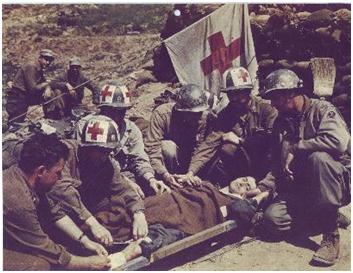
It wasn't any different to be killed in World War II then it was during the Civil War or World War I. However, if the World War II GI was wounded by a bullet, shrapnel or fallen by a disease such as malaria, without killing him, his chances for survival were much greater then his ancestor in the Civil War. During the Civil War, 50 percent or more of the men admitted to hospitals died, during World War I, it was 8 percent, World War II, 4 percent.
During World War II drugs such as sulfa (Sulfanilamide) and penicillin were discovered and advanced surgical techniques were introduced to make these improvements possible, but the first reason for such successes in improving the mortality rate was the speed with which wounded men were treated. It began with the frontline combat medics. In the beginning of the war at training camps, medics had been mildly despised because many of them were conscientious objectors and often ridiculed. Sometimes called "Pill Pushers" or worse. But in combat they were loved, respected and admired. Medic Buddy Gianelloni recalls, 'Overseas it becomes different. They called you medic and before you know it, it was Doc. I was 19 at the time."
During World War II drugs such as sulfa (Sulfanilamide) and penicillin were discovered and advanced surgical techniques were introduced to make these improvements possible, but the first reason for such successes in improving the mortality rate was the speed with which wounded men were treated. It began with the frontline combat medics. In the beginning of the war at training camps, medics had been mildly despised because many of them were conscientious objectors and often ridiculed. Sometimes called "Pill Pushers" or worse. But in combat they were loved, respected and admired. Medic Buddy Gianelloni recalls, 'Overseas it becomes different. They called you medic and before you know it, it was Doc. I was 19 at the time."
The main objective of the medic was to get the wounded away from the front lines. Many times this involved the medic climbing out from the protection of his foxhole during shelling or into no-man's-land to help a fallen comrade. Once with the wounded soldier, the medic would do a brief examination, evaluate the wound, apply a tourniquet if necessary, sometimes inject a vial of morphine, clean up the wound as best as possible and sprinkle sulfa powder on the wound followed by a bandage. Then he would drag or carry the patient out of harms way and to the rear. This was many times done under enemy fire or artillery shelling. In most cases, the Germans respected the Red Cross armband.
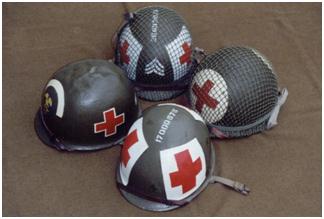
Vietnam War
During the Vietnam War the medic looked like any other Joe. He wore no distinguishing marks, markings on his helmet nor on his arms. He was just a regular guy like the rest of us. In a combat veteran will tell you how much they appreciated the medic and what he was willing to do for " his boys". In my own personal opinion at times I think the medics cared too much for the soldiers they were called upon to take care of. Unfortunately in war you have to do everything you can to control your feelings and distance yourself from the reality that people are going to die and there's nothing you can about that.
As in all the previous wars that we have experienced there are countless stories of the bravery and sacrifice and courage displayed by the medic and corpsmen during the most difficult of times, in the heat of battle. These guys would do anything to try to get the wounded soldier and in cases would have to be ordered to sit and wait because of the intense fighting that would be taking place. A wounded or dead medic can't help anyone.
These boys were given many medals of valor for their courage on the battlefield. In our Battalion, Donald Evans Junior received the Medal of Honor posthumously, and there were many who received the Silver Star and Bronze Star for valor.
We had wonderful support from all the medical teams who served in Vietnam and in all the remote camps in which they were deployed. There was the 45th surgical hospital in Tay Ninh, the 12th evacuation hospital in Cu Chi, and the main hospitals located in the Saigon area. The guys who flew the choppers running medevac's were all was a wonderful sight to behold. A wounded soldier could usually be picked up and placed in an emergency medical hospital within 20 to 25 min. of being wounded. One of the great things of the war was this ability to render aide to the wounded quickly and thus increasing their survivability rate.
Most of the guys who served in Dau Tieng or Camp Rainier may remember the aid station which was located in a two-story building. For others they may have experienced visiting the 12th Evac Hospital in Cu Chi.
As in all the previous wars that we have experienced there are countless stories of the bravery and sacrifice and courage displayed by the medic and corpsmen during the most difficult of times, in the heat of battle. These guys would do anything to try to get the wounded soldier and in cases would have to be ordered to sit and wait because of the intense fighting that would be taking place. A wounded or dead medic can't help anyone.
These boys were given many medals of valor for their courage on the battlefield. In our Battalion, Donald Evans Junior received the Medal of Honor posthumously, and there were many who received the Silver Star and Bronze Star for valor.
We had wonderful support from all the medical teams who served in Vietnam and in all the remote camps in which they were deployed. There was the 45th surgical hospital in Tay Ninh, the 12th evacuation hospital in Cu Chi, and the main hospitals located in the Saigon area. The guys who flew the choppers running medevac's were all was a wonderful sight to behold. A wounded soldier could usually be picked up and placed in an emergency medical hospital within 20 to 25 min. of being wounded. One of the great things of the war was this ability to render aide to the wounded quickly and thus increasing their survivability rate.
Most of the guys who served in Dau Tieng or Camp Rainier may remember the aid station which was located in a two-story building. For others they may have experienced visiting the 12th Evac Hospital in Cu Chi.
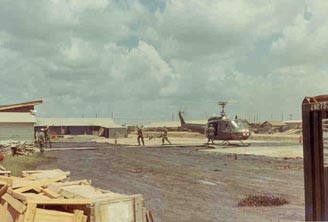
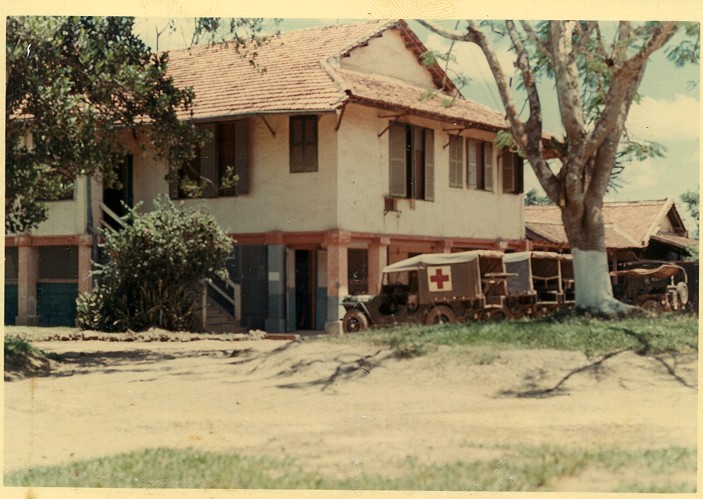
The medic once he joined the Battalion and reported to HHC would be assigned to a company then to a platoon where he usually served in the field for about six months before he would be reassigned to the Battalion aid station. I know we saw many medics out in the field during the time I served in third platoon, Charlie company. I loved all these guys and I know they felt the same about us.
During the Vietnam War, we lost 2096 medics on the battlefield. 1404 Army medics and 692 were Navy corpsmen. In our Battalion from the time we entered Vietnam in 1966 until we left at the end of March first part of April 1971, we lost 19 medics. A list of those fallen can be found listed under HONOR ROLL - HHC.
They took care of us. Whether it was dressing our wounds, giving us our malaria pills, or acting as our psychiatrist, they were always there for us.
During the Vietnam War, we lost 2096 medics on the battlefield. 1404 Army medics and 692 were Navy corpsmen. In our Battalion from the time we entered Vietnam in 1966 until we left at the end of March first part of April 1971, we lost 19 medics. A list of those fallen can be found listed under HONOR ROLL - HHC.
They took care of us. Whether it was dressing our wounds, giving us our malaria pills, or acting as our psychiatrist, they were always there for us.
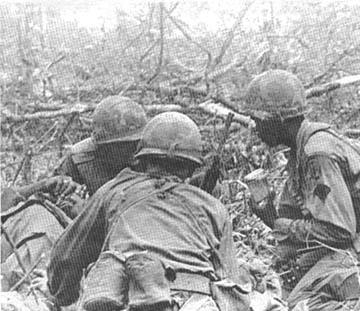
SP4 Rondual Tice, 2/12th, Medic
ADMINISTERING PLASMA to wounded member of his unit during recent action is medical aidman Specialist 4 Rondual E. Tice of St Petersburg, Fla., assigned to the 2d battalion, 12th Infantry. During the battle, elements of the 2d Brigade killed 170 members of an estimated NVA Battalion near Trang Bang. Later on in his tour, Tice will receive the Silver Star.
(PHOTO BY MAJ JOHN FAIRBANK)
ADMINISTERING PLASMA to wounded member of his unit during recent action is medical aidman Specialist 4 Rondual E. Tice of St Petersburg, Fla., assigned to the 2d battalion, 12th Infantry. During the battle, elements of the 2d Brigade killed 170 members of an estimated NVA Battalion near Trang Bang. Later on in his tour, Tice will receive the Silver Star.
(PHOTO BY MAJ JOHN FAIRBANK)


1st Aid Station _ Dau Tieng 12th Evac - Cu Chi



